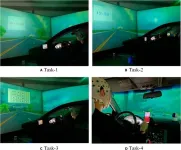(Press-News.org) The risk of death for people who donate a kidney for transplantation — already small a decade ago — has dropped by more than half since then, a new study shows.
Each year, roughly 6,000 Americans volunteer to donate a kidney, according to the Organ Procurement and Transplantation Network. Before undergoing the procedure, donors are informed of the potential risks, including death. Based on data from 1995 through 2009, experts had originally predicted that about three of every 10,000 donors were likely to die within three months of the procedure. The authors of the new study argue that advances in surgical techniques, donor selection, and postoperative care have since rendered that estimate out of date.
Analyzing three decades of medical records representing 164,593 kidney donors from across the country, a team led by researchers at NYU Langone Health found that by 2022, fewer than one death occurred for every 10,000 donations. That translates into 36 deaths in total over 30 years.
“While we had always understood that kidney donation is safe, our findings suggest that mortality among donors is extremely rare, and the procedure is safer than ever before,” said study lead author Allan Massie, PhD. Massie is director of the Center for Surgical and Transplant Applied Research (C-STAR) Quantitative Core at NYU Grossman School of Medicine, where he is also a faculty member in the Departments of Surgery and Population Health.
The results further showed that while their overall risk remained small, donors who were male and those with a history of high blood pressure were more likely to die within 90 days of surgery than other donors. Meanwhile, age, race, and ethnicity had no bearing on mortality.
Massie notes that surgical methods have changed dramatically since the 1990s, with open donor nephrectomy, in which surgeons make a 6-inch to 8-inch incision to remove the kidney, being almost entirely replaced by laparoscopic nephrectomy. In this less-invasive option, the organ is removed through a much smaller incision, with the procedure aided by a camera inserted through a thin tube.
The new report, publishing online Aug. 28 in the Journal of the American Medical Association (JAMA), is the first since 2009 to examine trends in mortality risk among living kidney donors. As a result, it better reflects the reality of organ donation in a time when laparoscopic nephrectomy is standard practice, the authors say.
For the study, the team analyzed information from the Scientific Registry of Transplant Recipients, a database of transplantation centers that is overseen by the U.S. Department of Health and Human Services. Death records were sourced from the Organ Procurement and Transplantation Network, the nonprofit organization that administers the nation’s only transplantation network authorized by the U.S. Congress.
The researchers calculated mortality rates within 90 days of donation, separated out into three time periods: 1993 through 2002, 2003 through 2012, and 2013 through 2022. Then, they compared deaths across the periods and considered different demographic and health factors, such as sex, body mass index (a measure of obesity), and whether the donors had an open or laparoscopic surgery.
Researchers found that about half of deaths occurred within the first week after donation, most commonly due to blood loss linked to surgery. In addition, mortality was similar from 1993 through 2012. Specifically, a total of 13 deaths occurred before 2003, with another 18 happening between 2003 and 2012. Meanwhile, there have been far fewer deaths since 2013, with five donors dying within 90 days of their procedure.
“These results demonstrate that the current guidelines used to inform potential kidney donors of their risks need to be updated to reflect nearly a decade of safety improvements,” said study senior author Dorry Segev, MD, PhD. Segev is a professor and vice chair in the Department of Surgery at NYU Grossman School of Medicine and director of C-STAR.
“As a kidney donor and research scientist in the field, it is reassuring to see the progress we have made,” said study co-author Macey Levan, JD, PhD, an associate professor in the Departments of Surgery and Population Health at NYU Grossman School of Medicine. and director of the C-STAR Qualitative Core. Levan is also the vice president of patient and donor affairs for the Organ Procurement and Transplantation Network and had donated her kidney to her cousin in 2009.
Funding for the study was provided by National Institutes of Health grants R01DK132395 and K24AI144954.
Segev has served as a consultant for pharmaceutical companies AstraZeneca, CareDx, Moderna Therapeutics, Novavax, and Regeneron, and has received speaker fees and honoraria from Springer Publishing, AstraZeneca, CareDx, Houston Methodist, Northwell Health, Optum Health Education, Sanofi, and WebMD. Study co-author Levan has received personal fees from the health-management platform PatientsLikeMe and from the pharmaceutical company Takeda. None of these groups were involved in the current study. The terms and conditions of all of these relationships are being managed in accordance with the policies and procedures with NYU Langone Health.
In addition to Massie, Segev, and Levan, another NYU Langone researcher involved in the study is Jennifer Motter, MHS. Jon Snyder, PhD, at the Hennepin Healthcare Research Institute in Minneapolis, Minn., also served as a study co-investigator.
Media Inquiries
David March (before Aug. 24)
212-404-3528
David.March@nyulangone.org
Shira Polan (after Aug. 25)
212-404-4279
Shira.Polan@nyulangone.org
END
Kidney donors’ risk of death at all-time low
2024-08-28
ELSE PRESS RELEASES FROM THIS DATE:
Thirty-year trends in perioperative mortality risk for living kidney donors
2024-08-28
About The Study: Perioperative mortality after living donation declined substantially in the past decade compared with prior decades, to fewer than 1 event per 10,000 donations. Risk was higher for male donors and donors with a history of hypertension. Current guidelines for donor informed consent, based on 2009 data, should be updated to reflect this information.
Corresponding Author: To contact the corresponding author, Dorry L. Segev, MD, PhD, email dorry.segev@nyulangone.org.
To access the embargoed study: Visit our For The Media website at this link https://media.jamanetwork.com/
(doi:10.1001/jama.2024.14527)
Editor’s Note: Please ...
Intersection of poverty and rurality for early-onset colorectal cancer survival
2024-08-28
About The Study: Patients with early-onset colorectal cancer (defined as colorectal cancer diagnosed in individuals younger than 50 years) living in rural areas had lower 5-year survival rates than their urban dwelling counterparts in this study. While it was not observed consistently for all age groups, persistent poverty in these rural areas may compound this association.
Corresponding Author: To contact the corresponding author, Meng-Han Tsai, PhD, metsai@augusta.edu.
To access the embargoed study: Visit our For The Media website at this link https://media.jamanetwork.com/
(doi:10.1001/jamanetworkopen.2024.30615)
Editor’s Note: Please ...
First-generation antihistamines and seizures in young children
2024-08-28
About The Study: Prescriptions for first-generation antihistamines were associated with a 22.0% higher seizure risk in children, especially in those ages 6 to 24 months in this cohort study. These findings emphasize the need for careful and judicious prescription of first-generation antihistamines in young children and underline the need for further research to elucidate associations between antihistamine prescriptions and seizure risk.
Corresponding Authors: To contact the corresponding authors, email Seonkyeong Rhie, MD, (starclusters@gmail.com) and Man Yong Han, MD, (drmesh@gmail.com).
To ...
Prioritizing the unexpected: New brain mechanism uncovered
2024-08-28
Researchers have discovered how two brain areas, neocortex and thalamus, work together to detect discrepancies between what animals expect from their environment and actual events. These prediction errors are implemented by selective boosting of unexpected sensory information. These findings enhance our understanding of predictive processing in the brain and could offer insights into how brain circuits are altered in autism spectrum disorders (ASDs) and schizophrenia spectrum disorders (SSDs).
The research, published today in Nature, outlines how scientists at the Sainsbury Wellcome Centre at UCL studied mice in a virtual reality ...
More people at risk of hereditary heart disease than thought
2024-08-28
More people in the UK are at risk of a hereditary form of cardiac amyloidosis, a potentially fatal heart condition, than previously thought, according to a new study led by researchers at UCL (University College London) and Queen Mary University of London.
The study, published in JAMA Cardiology, used data from the UK Biobank to analyse the genes of 469,789 people in the UK and found that one in 1,000 possessed genetic variants with a likely link to cardiac transthyretin (ATTR) amyloidosis.
Among ...
Breaking open the AI black box, team finds key chemistry for solar energy and beyond
2024-08-28
CHAMPAIGN, Ill. — Artificial intelligence is a powerful tool for researchers, but with a significant limitation: The inability to explain how it came to its decisions, a problem known as the “AI black box.” By combining AI with automated chemical synthesis and experimental validation, an interdisciplinary team of researchers at the University of Illinois Urbana-Champaign has opened up the black box to find the chemical principles that AI relied on to improve molecules for harvesting solar energy.
The result produced light-harvesting molecules four times more stable than ...
Discovery of how blood clots harm brain and body in COVID-19 points to new therapy
2024-08-28
In a study that reshapes what we know about COVID-19 and its most perplexing symptoms, scientists have discovered that the blood coagulation protein fibrin causes the unusual clotting and inflammation that have become hallmarks of the disease, while also suppressing the body’s ability to clear the virus.
Importantly, the team also identified a new antibody therapy to combat all of these deleterious effects.
Published in Nature, the study by Gladstone Institutes and collaborators overturns the prevailing ...
JAMA review highlights advances in kidney cancer research and care
2024-08-28
CHAPEL HILL, North Carolina — New insights into the biology of kidney cancer, including those informed by scientific discoveries that earned a Nobel Prize, have led to advances in treatment and increased survival rates, according to a review by UNC Lineberger Comprehensive Cancer Center’s William Kim, MD, and Tracy Rose, MD, MPH.
Their observations, drawn from a meta-analysis of 89 studies published between January 2013 and January 2024, were published in JAMA Aug. 28.
“The Nobel Prize in Medicine or Physiology in 2019 was awarded ...
new diabetes research in Scientific Reports links blood glucose levels and voice
2024-08-28
NEW YORK/TORONTO – August 28, 2024 – As part of its ongoing exploration of vocal biomarkers and the role they can play in enhancing health outcomes, Klick Labs published a new study in Scientific Reports today – confirming the link between blood glucose levels and voice pitch and opening the door to future advancements in non-invasive glucose monitoring for people living with Type 2 diabetes.
In “Linear Effects of Glucose Levels on Voice Fundamental Frequency in Type 2 diabetes and Individuals with Normoglycemia,” researchers ...
Augmented recognition of distracted driving state based on electrophysiological analysis of brain network
2024-08-28
A research paper by scientists at Beijing Jiaotong University proposed an electrophysiological analysis-based brain network method for the augmented recognition of different types of distractions during driving.
The new research paper, published on Jul. 04 in the journal Cyborg and Bionic Systems, designed and conducted a simulated experiment comprising 4 distracted driving subtasks. Three connectivity indices, including both linear and nonlinear synchronization measures, were chosen to construct the brain network. By computing connectivity strengths and topological features, we explored the potential relationship between brain network configurations and states ...




